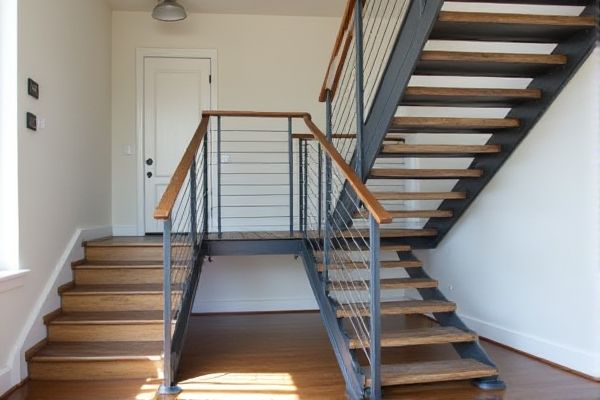
Steel stairs offer superior durability and strength, making them ideal for heavy-duty applications and long-term use, while aluminum stairs provide lightweight, corrosion-resistant options perfect for outdoor settings and easy installation. Discover which material best suits Your project's needs by exploring the detailed comparison in the rest of this article.
Table of Comparison
| Feature | Steel Stairs | Aluminum Stairs |
|---|---|---|
| Material Strength | High tensile strength; supports heavy loads | Moderate strength; suitable for light to medium loads |
| Weight | Heavy; requires strong support structures | Lightweight; easy to install and transport |
| Corrosion Resistance | Prone to rust unless properly coated or galvanized | Excellent corrosion resistance; ideal for outdoor use |
| Maintenance | Needs regular painting or anti-rust treatment | Low maintenance; minimal upkeep required |
| Cost | Generally lower initial cost | Higher initial cost but lower lifetime maintenance |
| Durability | Very durable with proper maintenance | Durable and lightweight but less impact-resistant |
| Design Flexibility | Limited; heavier gauge metal limits complexity | Highly flexible; easy to shape and customize |
| Environmental Impact | Higher carbon footprint due to steel production | Lower environmental impact; recyclable and sustainable |
Introduction to Steel and Aluminum Stairs
Steel stairs offer exceptional strength, durability, and load-bearing capacity, making them ideal for industrial and commercial applications where safety and longevity are crucial. Aluminum stairs provide a lightweight, corrosion-resistant alternative, favored for outdoor settings and environments exposed to moisture due to their superior rust resistance. Both materials support diverse design options, but steel stairs typically require less maintenance and offer a robust structural solution compared to aluminum.
Material Composition: Steel vs Aluminum
Steel stairs are composed primarily of iron alloyed with carbon, offering superior strength and durability, ideal for heavy-duty applications and high-traffic areas. Aluminum stairs consist of a lightweight metal alloy known for its corrosion resistance and ease of maintenance, making them suitable for outdoor or marine environments. Choosing between steel and aluminum stairs depends on your priorities for load capacity, weight, and environmental exposure.
Strength and Durability Comparison
Steel stairs offer superior strength and durability, with a tensile strength ranging between 400 to 550 MPa, making them ideal for heavy loads and high-traffic areas. Aluminum stairs, while lighter and corrosion-resistant, have a lower tensile strength of approximately 150 to 300 MPa, which may limit their use in industrial or heavily trafficked environments. The longevity of steel stairs is enhanced by protective coatings against rust, whereas aluminum naturally resists corrosion but can suffer from surface wear over time.
Weight and Load-Bearing Capabilities
Steel stairs offer superior load-bearing capabilities due to their high density and strength, making them ideal for heavy-duty applications and industrial settings. Aluminum stairs are significantly lighter, which simplifies installation and reduces structural load but may compromise maximum weight capacity compared to steel. Your choice should balance the need for durability and strength with ease of handling and weight constraints.
Corrosion Resistance and Longevity
Steel stairs offer exceptional strength but require protective coatings to resist corrosion and can rust over time if not maintained properly. Aluminum stairs provide superior corrosion resistance due to their natural oxide layer, ensuring longer-lasting durability in outdoor or humid environments. Your choice will depend on whether you prioritize the robust strength of steel or the low-maintenance longevity of aluminum.
Design Flexibility and Aesthetic Options
Steel stairs offer exceptional design flexibility, allowing intricate shapes, custom railings, and a wide range of finishes for a sleek, industrial look. Aluminum stairs provide lightweight versatility with modern, clean lines and corrosion-resistant properties ideal for outdoor or coastal environments. Your choice depends on whether you prioritize robust customization with steel or the effortless elegance and durability of aluminum.
Installation Process and Ease
Steel stairs require welding and bolting during installation, demanding skilled labor and specialized tools, which can increase overall time and complexity. Aluminum stairs are lighter and often feature modular, bolt-together components that simplify handling and reduce installation time significantly. The corrosion-resistant nature of aluminum also eliminates the need for additional protective coatings, streamlining the installation process.
Maintenance Requirements and Cost
Steel stairs demand regular maintenance to prevent rust and corrosion, often requiring periodic painting or sealing, which can add to long-term upkeep costs. Aluminum stairs offer superior resistance to rust and require minimal maintenance, making them cost-effective over time despite a higher initial price. Your choice between steel and aluminum stairs should consider both upfront expenses and ongoing maintenance commitments.
Environmental Impact and Sustainability
Steel stairs often have a higher carbon footprint due to energy-intensive production processes and lower recyclability rates compared to aluminum stairs. Aluminum, being lightweight and highly recyclable with up to 95% recycling efficiency, offers a more sustainable option with reduced environmental impact. Both materials benefit from advancements in recycling technologies, but aluminum's ability to retain quality through multiple recycling cycles makes it preferable for eco-conscious construction.
Cost Analysis: Steel Stairs vs Aluminum Stairs
Steel stairs generally have a lower initial cost compared to aluminum stairs due to the abundance and lower price of raw steel materials. Aluminum stairs offer superior corrosion resistance and require less maintenance, potentially reducing long-term expenses despite their higher upfront price. When evaluating your budget, consider both the material costs and lifecycle maintenance to determine the most cost-effective choice for your project.
 homyna.com
homyna.com